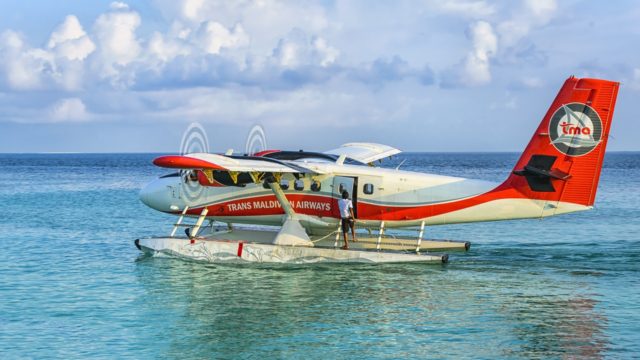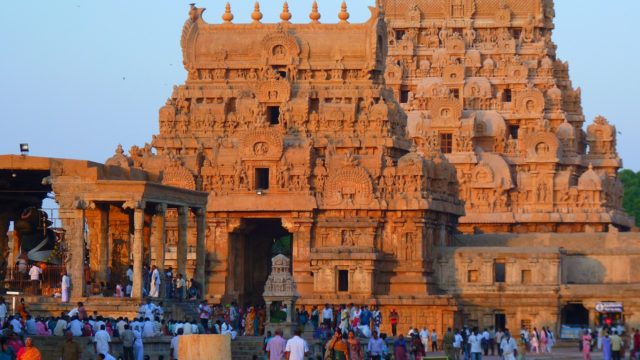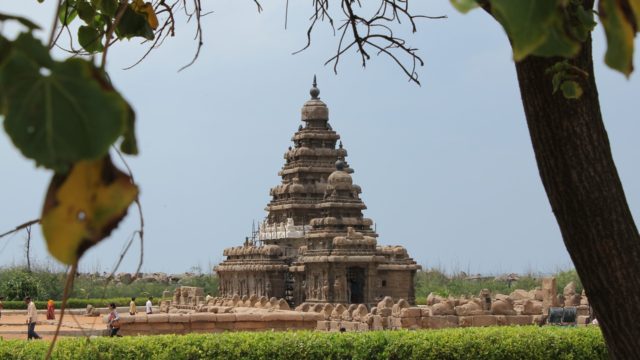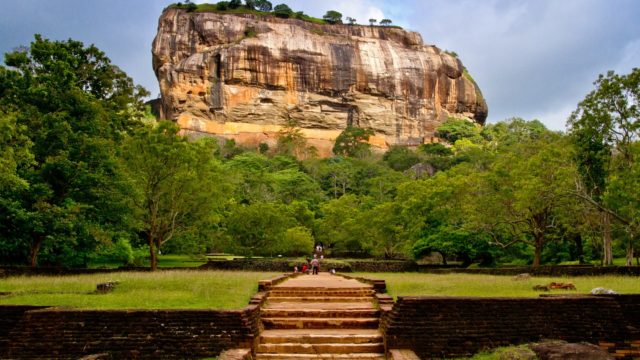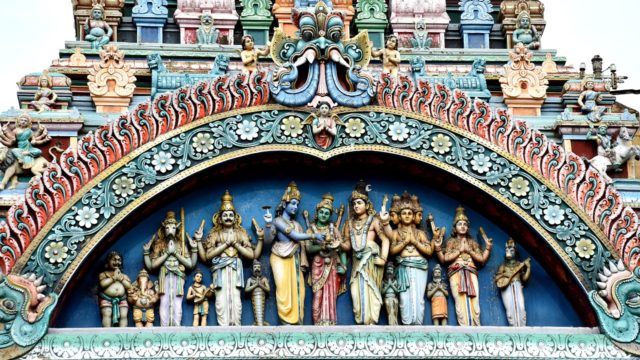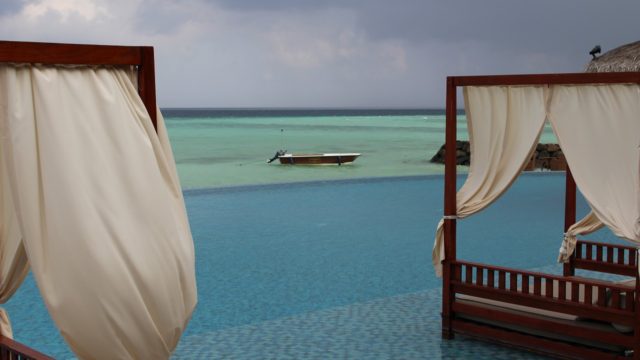This is a once in a lifetime experience.
- Visit Chennai and its countless attractions.
- Visit Kanchipuram, the city of the a thousand temples.
- Visit Mahabalipuram, seaside capital of the Pallava kings, famed for its shore temples and remarkable, lifelike rock carvings of animals, deities and village life 1400 years ago.
- Visit Pondicherry, the french village in India.
- Visit to Chidambaram, Kumbakonam, Darasuram and Gongaikonda.
- Full day in Tanjore, including the Tanjavur palace, The Chola temple of Brihadeeshwara and its art gallery.
- Visit to Trichy and Madurai. In Trichy you will have the tour of Rockfort temple. The 83m high Rock Fort is the only outcrop in the otherwise flat land of the city.
- Full day in Madurai, one of the oldest cities in southern India. It has been a center of pilgrimage for centuries.
- Go to Aleppy for a houseboat experience for the next two days through the narrow canals and channels of the backwaters of Kerala.
- Air transfer to Colombo Sri-Lanka.
- Once in Colombi, visit the Pinnawela elephant orphanage, one of the most popular attractions of Sri Lanka. Before the arrival of the British in 1815 an estimated 30,000 elephants lived on the island. In the 1960s, the elephant population was close to extinction.
- Full day at Sigiriya, also known as Lion Rock, is the shortest-lived but most extraordinary of all of Sri Lanka’s medieval capitals.
- Visit to Aukama, Mihintale, Anuradhapura and Kandy.
- Air transfer to Maldives Islands.
- Three days enjoying the heavenly Maldives Islands.
Day 1. Saturday. USA / Chennai-India
Today take your overnight flight to Chennai India.
Overnight: En Route
Day 2. Sunday. Chennai.
Upon arrival this afternoon, clear immigration (visa required for India), continue to collect your luggage and proceed through customs to the exit where you will be met and transferred to the hotel . Check in and enjoy the rest of your day at leisure and a proper good night’s sleep.
Overnight: The Ideal Beach Resort. (B)
Day 3. Monday. Chennai / Kanchipuram / Mahabalipuram.
Let the adventure begin. After a sleep in and leisurely breakfast, you will be met at 10:00am and drive south to the amazing temples of Kanchipuram. -The City of a Thousand Temples, it is one of the most spectacular temple cities of India. The domineering gopurams of the temples can be seen from several kilometres away as you get close to arriving into the area. Kanchipuram, a Hindu Holy City and capital of the Pallava dynasty from the 7th to 9th centuries AD, is renowned for temples and silk, and you will see plenty of both.
The temples range in date from the 8th to the 17th century. The latest building was impressive in its size, the height of its gopuram, the intricacy of its carvings and wealth of colour, but, the earliest temples, of golden sandstone, are more aesthetically pleasing, the only colour provided is by a flock of ring-necked parakeets.
Once known as Siva Vishnu Kanchi, Kanchipuram is amongst the seven most sacred pilgrim centres of the Hindus. Kanchipuram was the capital of Pallavas between the 6th and 8th century A.D. The Pallavas were succeeded by the Cholas and the Vijaynagar rulers. The Pallavas, Cholas and Vijaynagar rulers built many temples at Kanchipuram, the legacy of these dynasties can be seen in these magnificent temples. There are 126 temples in Kanchi and few more on its outskirts. Notable among them are Ekambaranatha Temple, Kamakshi Amman Temple, Varadharaja Perumal Temple, and the Kumara Kottam. Kanchipuram is divided into two sects; Vishnu Kanchi, where all the Vishnu Temples are found and Shivan Kanchi where all the Shivan and Shakthi Temples are found. After the Kanchipuram visit, we will continue our drive to Mahabalipuram, reaching by sunset.
Overnight: The Ideal Beach Resort. (B)
Day 4. Tuesday. Mahabalipuram.
Visit Mahabalipuram, seaside capital of the Pallava kings, famed for its shore temples and remarkable, lifelike rock carvings of animals, deities and village life 1400 years ago. Good seafood and a fine beach are among the other attractions to sample in town. Visit the golden Pilgrimage City of silks and shrines. On our way we stop to watch some fishermen hollowing out canoes from tree trunks. You could also witness similar craft being hauled out of the sea and fishermen unloading their catch, watched by fish-eagles hoping, no doubt, for a share. Return to the resort for lunch break on your own.
This afternoon, we will visit The Arjuna’s penance. This is one of the most famous stone carvings at Mahabalipuram. It is an enormous relief made on two massive boulders. One of the biggest open-air rock canvases in the world, the Arjuna’s penance is 31m long and 9m high. The surface of the rock has detailed carvings, showing the most endearing and natural renditions of animals especially the elephants and monkeys.
The skillfully carved edifice, Arjuna’s penance, is named after the Mahabharatha hero, Arjuna. As mentioned above, the subject of the carving is either how Arjuna, one of the Pandava brothers, performed severe austerities so that he could obtain Lord Shiva’s weapon to destroy his enemies or an illustration of how King Bhagiratha brought the River Ganges down to earth so that the souls of his ancestors could rest in peace.
Later, you may also visit The five Rathas, which is a set of magnificent monolithic rock temples. Panch is a Hindi world which means ‘Five’. These fine rock temples are located in a sandy compound. These five Rathas are the perfect examples of the evolution of Dravidian style architecture.
Following the temples tour, we would visit DakshinaChitra, is a center for the living traditions of art, folk performing arts, craft and architecture of India with an emphasis on the traditions of South India. A project of the Madras Craft Foundation (MCF), a non-profit organisation. DakshinaChitra opened to the public in December 1996.
Overnight: The Ideal Beach Resort. (B)
Day 5. Wednesday. Mahabalipuram / Auroville / Pondicherry.
Following breakfast, we will depart at 9:00am and drive to Pondicherry en route we will visit Auroville.
Upon arrival, we visit Sri Aurobindo Ashram has grown Founded in 1926, under the Mother’s guidance, from a small group of two dozen disciples into a large diversified community with almost 1200 members. Counting the 400 students of the Centre of Education and the hundreds of devotees who live nearby, the larger ashram community consists of more than 2000 people. The Ashram is located in the eastern part of Pondicherry suburbs. Ashramites live and work in a large number of buildings spread throughout the area.
From here, we will continue our drive to Pondicherry arriving in time for lunch and a break around 1:00pm and check in to the Hotel De L’Orient.
AFTERNOON WALKING TOUR: During a pleasant afternoon stroll you could hear French spoken frequently. The town still has the feel of a French provincial town, with its librairie, epicerie, imposing Hotel de Ville, memorial to Franco-Indians killed in the Great War, and statue of Joan of Arc. The houses could be anywhere in southern France and bear the familiar white numbers on a blue ground.
Overnight: Hotel De L’ Orient. (B)
Day 6. Thursday. Pondicherry / Chidambaram / Kumbakonam / Darasuram / Gongaikonda / Tanjore.
This morning we set out on a fascinating day to Thanjavur. Enroute we will visit Chidambaram, Kumkakonam, Darasuram & Gangaikonda.
Chidambram is in between two rivers in a 40 acres temple-complex, it is one of the oldest and magnificent temples of the South. Shiva Natrala or the Dancing Shiva stands in his cosmic dance pose in the golden rooted sanctorum.
Kumbakonam is flooded with temples of large size. There are as many as sixty temples, in and around Kumbakonam within 40-km of radius. Of the many temples in Kumbakonam, the oldest Shaiva fane is the Adikumbeshwara and the oldest Vaishnava fane, the Sri Sarangapani.
Darasuram is a ‘Sculptor’s dream in stone’, musical pillars, mandapam in the shape of a chariot, a wealth of sculpture and painting are synonymous with Airavateshvara Temple. The temple dedicated to Lord Shiva, is a well-preserved example of 12th century Chola architecture.
We drive through the tropical mountains to Gangaikonda through the Coleroon river delta.. The ancient town of Gangai Konda Cholapuram in Tamil Nadu is an hour’s drive from Chidambram. It was the capital of the Cholas till their fall in the 13th century. This place is well known for the Gangai Konda Cholapuram temple which was built in 11th century, to commemorate Chola King’s conquest up to the Gangetic plain.
Overnight: The Ideal River View Resort.(B)
Day 7. Friday. Tanjore.
Set out for the morning tour of the Tanjavur Palace. It has huge halls, spacious corridors, observation & arsenal towers and a shady courtyard. Though many sections of the palace are in ruins restoration work has been taken up. The palace houses a library, a museum and an art gallery. The Royal museum displays many items from the kings who ruled the place in past. The eclectic collection of royal memorabilia can fascinate any visitor. The Royal cloths, hunting weapons, the head gears and many more such items are enough to catch the attention of any one. There are two Durbar halls where the rulers held public meetings. Though they have not been renovated, they are in good shape.
The Nayak hall of the palace is occupied by the Art Gallery. This gallery has an excellent collection of artifacts from the Chola dynasty during the 8th and 9th century. The bronze and granite statues reflect the height of craftsmanship obtained during those days. The bell tower which was put under restoration work, has emerged very different from the rest of the structure after renovation. But it is worth going up the tower to have a good view of the surrounding area. Next to the art gallery is the Saraswathi Mahal Library with an amazing collection of manuscripts on palm leaves and paper. The library is not open for the public. But one can always go in the museum to have a look at the full Ramayana written on Palm leaf or a set of explicit prints of prisoners.
This afternoon at 2:00pm, you will be met and continue the afternoon exploring Tanjore. See the beautiful Chola temple of Brihadeeshwara. The temple is capped by a monolithic cupola made of a single granite block weighing 80 tons which was taken to the top with the help of a 6 km long ramp- an old technique used by the Egyptians for building pyramids. You will also visit the Palace and its Art Gallery, which contains several granite and bronze statues of the Chola period.
Overnight: The Ideal River View Resort.(B)
Day 8. Saturday. Tanjore / Trichy / Madurai.
We set our and drive to Trichy. Upon arrival at Trichy, we will have tour of Rockfort Temple. The 83m high Rock Fort is the only outcrop in the otherwise flat land of the city.
The rock is one of the oldest in the world-approximately 3.800 million years, which makes it as old as the rocks of Greenland and older than the Himalayas. The sheer abruptness of its rise is a thrill in itself, but the actual centre of attraction is not the fort itself, of which very little remains, but the temple at the summit. 344 steps hewn out of rock lead to the top where there are inscriptions dating back to the 3rd century.B.C. Hardly anything remains of the ramparts but the Main Guard Gate is still intact.
At the top of the rock is the Uchipillaiyar Koil, a temple dedicated to Lord Vinayaka from where one can enjoy a panoramic view of Tiruchirappalli. A flight of steps leads to the Mathrubutheswarar of Thayumanaswami temple, dedicated to Lord Siva where the lingam is a projection of the rock itself. Below the Siva temple are the two Pallava cave temples that have beautiful sculptures of the 6th and 7th centuries. At the foot of the Rock Fort are a tank and a pavilion which are used during the float festival of the temples. Near the tank is the house where Robert Clive lived when he was in Tiruchirappalli and there is an 18th century Church built by Reverend Schwartz of Denmark. The temple resident elephant in the rock fort temple collects donations, giving a blessing and hands over the money to his “boss” From here we will continue our drive to Madurai and check in to our hotel.
Overnight: The Heritage Madurai. (BD)
Day 9. Sunday. Madurai.
Today we will proceed on a tour of Madurai. Madurai is one of the oldest cities of southern India. It has been a center of pilgrimage, for centuries. The Meenakshi temple, the main architectural attraction here, is an excellent example of Dravidian architecture, with gopurams or multi pillared halls, covered from top to bottom, in a profusion of multicolored images of gods, goddesses, animals and mythical figures.
Our first stop is at the Meenakshi Temple. The Meenakshi Temple is the landmark of Tamil Nadu. There is a mythological story attached to the temple. Malayadwaja Pandya, the then ruler of Maduri had no heir to his throne so he performed several yagnas (sacrificies made before a sacred fire). Finally a little girl child arose from the fire who was an
incarnation of goddess Parvati.
Sundareshwaram temple: The temple houses huge gopuram’s, the tallest being 48 meters in height. Numerous imposing sculptures have been carved inside the temple. Impressive mandaps, tanks, shrines, images of goddess Parvati and Lord Shiva are the attractions here. It is said that the wedding of Shiv and Parvati was solemnized in this temple. Spend most of the morning at the main temple in town, soaking up the history and learing and viewing this great architectural wonder.
During afternoon we will visit the Tirumala Nayak Palace – A gracious building in the Indo saracenic style, famous for the Stucco work on its domes & arches. Also visit the Alagar Hills and Tirupara Kundran Rock temple. However, besides the temple, our tour includes a walk along the main street leading to the temple. The well-organized confusion caused by pilgrims in traditional clothes, pavement shops of all shades, holy men in robes of different colours etc add an unmistakable colour and atmosphere to this fascinating Temple City. Return to the hotel at the end of the afternoon for some leisure time.
Overnight: The Heritage Madurai. (B)
Day 10. Monday. Madurai.
we continue our drive to Tekkady, where the Tea and Pepper are grown. Lush green rolling hills and plantations abound. The drive to Periyar is through the scenically vibrant valley of the Cardamom Hills of the Western Ghats. The Periyar Wildlife Sanctuary at Thekkady in Kerala, is one of the 16 Project Tiger Reserves in India. About a century ago, a British engineer, Col. J. Penn ycuick, chalked out a plan to dam the Periyar River, subsequently, a dam was constructed in 1895. This resulted in the adjoining forests being granted protection, by the Maharaja of Travancore. The 55 sq km reservoir and the surrounding forests, provide protection to the animals within. Today, Periyar is undeniably, one of the most impressive wildlife sanctuaries in the world.
we continue our drive to Tekkady, where the Tea and Pepper are grown. Lush green rolling hills and plantations abound. The drive to Periyar is through the scenically vibrant valley of the Cardamom Hills of the Western Ghats. The Periyar Wildlife Sanctuary at Thekkady in Kerala, is one of the 16 Project Tiger Reserves in India. About a century ago, a British engineer, Col. J. Penn ycuick, chalked out a plan to dam the Periyar River, subsequently, a dam was constructed in 1895. This resulted in the adjoining forests being granted protection, by the Maharaja of Travancore. The 55 sq km reservoir and the surrounding forests, provide protection to the animals within. Today, Periyar is undeniably, one of the most impressive wildlife sanctuaries in the world.
Spice Village is an unprecedented tourist destination, offering a rare opportunity to enjoy South India’s wildlife and beauty. The village lies just outside Periyar Tiger
Reserve, and a stay here is the perfect way to appreciate and respect the environment. This is a place for everyone who loves nature: somewhere to fill your lungs with fresh mountain air, to savor the rich fragrance of cinnamon and cloves, to watch young elephants drinking at the water’s edge. The resort itself provides every comfort the modern traveler could wish for – luxurious accommodation, mouth-watering cuisine, and an exclusive swimming pool. – Bicycles are reserved for you during your stay. We recommend from 2:00pm – 3:30pm, jump aboard your bicycles and explore for a couple of hours, the great scenery nearby.
SUNSET: We will enjoy a shared group boat ride along the lake into the more inner areas of the reserve. There is probably no sanctuary in the world where elephant behavior can be watched in such absolute comfort and safety. The total popula¬tion is about 800. From the lake we can get as close as 20 meters to watch placid groups feeding, bathing and mud slinging.
Overnight: The Spice Village. (B).
Day 11. Tuesday. Tekaddy Lake Periyar.
We meet with the resident naturalist and take off on a small group hike which is an interesting full day exploration of the lush green forests.
First we would take a short trek inside the forest. The birdlife comprises of darters, cormorants, kingfishers, great hornbills (the great Malabar hornbill) and racket-tailed drongoes. The reptilian population boasts of monitor lizards that can be spotted basking in the sun, on the rocks along the lakeshore, especially in the cooler months. Pythons, king cobras, flying lizards, flying squirrels, flying snakes and to top it all, flying frogs are the other inhabitants of this amazing sanctuary.
After the trek, we board rafts made of bamboos for a rafting experience through some of the richest forest tracts of Periyar Tiger Reserve. The rafting is for about three hours and one gets a panoramic view of forest-clad hills reflected on the lake. Animals like elephant, gaur and sambar are sighted keeping close to the edges of the lake. Since our rafts are silent, only your voices scare away the animals, so watch as we drift along and catch scenes you may not otherwise would have thought possible. Be prepared to paddle and get fantastic exercise today.
Overnight: The Spice Village. (B,L).
Day 12. Wednesday.Tekkady / Aleppy / Pallathuruthy / Kanjippadam / Karumadi.
We ride to Alleppey for a houseboat experience through the narrow canals and channels of the backwaters of Kerala. Upon arrival at Alleppy river pier, our private houseboat is waiting as we step aboard and our luggage is transferred. The crew are busy preparing a hot lunch as they kick off and start the idyllic cruise through the backwaters of Kerala.
We spend the rest of the day cruising on our boat through remote tribal villages along the tranquil backwaters of Kerala is a superb experience. Sensational in its own silent way, the cruise takes you along snake boat docks, friendly cheering villagers, coir (Jute) making communities, toddy (local spirit) shops, fishing nets pitched for the day’s catch, bunded paddy fields and manual canoes of different sizes criss-crossing each other. The experience enables you to reach beautiful untouched areas.
Built in the 9th century AD, Aleppy, called Alappuzha lies on the edge of the great Ashtamudi lake. With the Arabian Sea on the west and a vast labyrinth of lakes, lagoons and several freshwater rivers criss-crossing it, Alappuzha is a district of immense natural beauty. Related to the Venice of the East by travellers from around the world, this backwater country is also home to diverse range of animals and birds. It has always been honored a unique place in the maritime history of Kerala for its proximity to the sea.
Overnight: Private one bedroom Houseboat. (B,L,D) Breakfast at Spice Village and Lunch and Dinner on board houseboat.
Day 13. Thursday. Kerala Backwaters.
This morning we have breakfast on board with the sounds of backwater birds in the background.
The waterways of Kerala play a main role in the economy of the state by linking remote villages and islands with the main land. The waterways provide a cheap and economical mode of transport. It is an incredibly different experience to cruise in the backwaters in houseboat or country boats, absorbing the beauty of Kerala villages from the river. The scenery flashes up vivid contrasts of breathtaking greens and deep blues.
We will start our cruise around 10 AM to the towns of Munnattumukham via Karumadi, Thottapalli, Karuvatta, Thakazhi, Champakulam & Nedumudi.
These are all wonderful towns to stop and walk along as we cruise the backwaters. At Karumadi for example, you can visit the Buddha in it’s temple. Although mostly Christian in faith, the Keralites have respect for all religions which is evident in the upkeep of various temples, shrines and churches.
Breakfast, Lunch and Dinner is served on board during the day and evening moored on the lake
in a peaceful setting.
Overnight: Private one bedroom Houseboat. (BLD)
Day 14. Friday. Kumarkarom / Aleppy / Cochin.
Disembark the cruise back at Aleppy Pier. After rest & relaxation, at 1:00pm, we proceed on a guided tour of the City. The true character of the city is to be found in the older parts of the Fort Cochin area. It more or less exists as it used to be a 1000 years back, when it was first built. The roads have not been widened because the old haggard buildings, through patchwork repairs over the centuries, still stand on the edges. This part of the city reflects an unusual blend of medieval Portugal, Dutch and English country life grafted on to the tropical Malabar Coast.
The fishing community of Cochin is also very interesting. They ancient cantilevered fishing nets called Chinese Fishing Nets. The net is fixed to a pole on the shore. While fishing, the entire net is lowered by a primitive fulcrum mechanism using long bamboo poles. By the same mechanism the pole is lifted along with the catch. We will explore the sights of Photographic as well as cultural interest.
We would also visit the 16th century Mattancherry Palace, also known as the Dutch Palace since the Dutch substantially renovated the palace in the 17th century. The double storied quadrangular building surrounds a courtyard containing a Hindu temple.
Cochin – Kochi (Cochin) is rightly termed as the ‘Queen of the Arabian Sea’ with a number of islands and promontories between the Arabian Sea and backwaters. It spreads across modern Ernakulam in the east and the old districts of Mattancherry and Fort Cochin in the west, which are interconnected by romantic ferries and bridges. This conclusion to our afternoon tour is relaxing as we have some time with the guide to walk around this area. You will be back to the hotel late this afternoon which should allow free time from 4:30pm – 5:30pm. Then you will need to discuss with your guide the evening pick up time, fit in dinner and relaxation.
Overnight: Brunton Boat Yard Hotel. (B)
Day 15. Saturday. Cochin / Colombo / Pinnewala / Sigiriya.
This morning you will be met and transferred – one hour drive to the Kochi airport for your Sri Lankan Airlines flight to Colombo Sri Lanka. (No Visa required on arrival) On arrival clear immigration, collect your luggage and meet your driver guide in the arrivals hall, estimated to be 12:30pm. We load up the car and drive north as we wind our way from the airport, a short distance and then turn further north and start our ascent through the hills and travel north towards our destination Sigiriya with stops along the way.
As we wind up the hills along a winding route, we will make our first stop after about two hours at the hilly town of Pinnewala. We will stop and learn about the great Elephants and see the babies and moms and dads orphaned from the civil war. Pinnawela elephant orphanage has existed since 1975 and has grown to become one of the most popular attractions of Sri Lanka. Before the arrival of the British in 1815 an estimated 30,000 elephants lived on the island. In the 1960s, the elephant population was close to extinction. This prompted the Sri Lankan government to found an orphanage for elephants that had lost their mothers or herds. Today, their number is around 3,000.
After our visit to Pinnewala, we continue our drive north and then inland to Sigiriya. One of the major sights that unfold before you is the great Sigiriya Rock fortress in the distance, which is one of the sights you will visit and hike in the days to come. Enjoy the scene as we wind into our luxury resort.
Overnight: The Elephant Corridor Resort. (B)
Day 16. Sunday. Sigiriya.
Sigiriya, also known as Lion Rock, is the shortest-lived but most extraordinary of all of Sri Lanka’s medieval capitals. A remarkable archaeological site made unforgettable by its dramatic setting, the Sigiriya citadel was declared a World Heritage Site by UNESCO in 1982 and is one of the country’s most memorable attractions. The rock mass is actually the hardened magma plug of an extinct volcano that long ago eroded away. Pocked with natural caves and rock overhangs, the rock may have had many inhabitants during prehistoric times. Supposedly, it was not until the 5th century CE that Sigiriya rose to distinction in Sri Lankan affairs- Dhatusena of Anuradhapura had two sons, Mogollana, by the most superior of his various queens, and Kashyapa, his son by a lesser consort. Upon hearing that Mogollana had been declared heir to the throne, Kashyapa rebelled, driving Mogollana into exile in India and imprisoning his father. The legend of Dhatusena’s subsequent demise offers an instructive illustration of the importance given to water in early Sinhalese civilization. In 491 CE, Mogallana raised an army of Tamil mercenaries to invade Sigiriya and reclaim his inheritance. Despite the benefits of the impregnable fortress, Kashyapa descended from his rocky eminence in an act of bravado and rode boldly out on an elephant. Unfortunately for Kashyapa, his elephant took fright and bolted during the battle, leaving his troops to think they were retreating. Facing capture and defeat, Kashyapa killed himself.
Whatever Sigiriya’s history may be, the ruins visible today suggest a significant urban site complete with sophisticated architecture, engineering, urban planning, hydraulic technology, gardening and art. Once at the top, enjoy the views and the history as imagine once, a great kingdom palace was here. The Royal Gardens, comprising the Water Gardens, the Boulder Gardens and the Terrace Gardens, are landscaped gardens around Sigiriya.
Overnight: The Elephant Corridor Resort. (B)
Day 17. Monday. Sigiriya / Aukama / Mihintale / Anuradhapura / Sigirya.
At 8.00am you will be met by your guide and start driving towards Anuradhapura and start the city tour of ancient city (3rd century B.C to 10th century A.D). En route we will
drive via Aukana & then to Mihintale to visit the rock temple before reaching Anuradhapura. After visiting the city, your guide will recommend an early stop for lunch in Anuradhapura and proceed to Mihintale. Visit Mihintale Monastery complex built in the 3rd century B.C.
Ruins of an Ancient hospital, Refectory hall, Lion pond, Cobra pond, Ambastale, and Mihindu cave and then proceed to Aukana to see the highest buddha statue in Sri Lanka, in one piece of granite 13 meters in height built in the 5th century A.D. This statue was built by King Datusena while he was building the gigantic reservoir called Kala Wewa.
AFTERNOON: Visit Sri maha bodhi ( The oldest tree in the world with a written history and it is a saplin from the original tree which the Buddha attained enlightment under it), The brazen palace, Ruwanveli seya dagoba (The biggest Pagoda in Sri Lanka), Thuparama dagoba (oldest dagoba built in the 3rd century B.C, the right color borne of Buddha is deposited), Lankarama dagoba, Elephant pond, Abhayagiriya monestry complex, World famous Samadhi Buddha statue, Twin ponds, The finest stone carving and the meaning of the Moonstone, The guard stone, Jethavanarama dagoba and Museum and Isurumuniya temple (Stone carving of the Sri Lankan Romeo & Juliet).
After touring is complete, we will leave Anuradhapura and drive back to Sigiriya reaching by sunset with your evening free at leisure.
Overnight: The Elephant Corridor Resort. (B)
Day 18. Tuesday. Sigiriya / Kandy / Colombo City.
You will be met at 7:30am and drive to Kandy to spend the morning. Kandy, the last royal capital of Sri Lanka is a major tourist destination. ( 115kM from Colombo at 465 meters above sea level). Famous for the Temple of the Tooth and many other temples the city could be called the cultural capital of the island. Kandy Perahera, the pageant of the temple of tooth where Buddha’s tooth is kept is held either in July or August each year to parade the golden caskets is a must see itinerary if one is visiting Sri Lanka during these months. The final night procession is the most spectacular event of the country. More than 50 elephants parade the city accompanied by the drummers, dancers and chieftains. The city is also a good source of souvenirs or to experience many cultural performances at its various hotels in the city. You will visit the main sights of Kandy including the Temple of the Tooth before breaking for and early lunch on your own at one of the main hotels or restaurants.
After lunch, we drive south back down to Colombo. We have a brief tour of the city and the main sights of town on a drive through, with some brief stops for photographs. After an hour or so of Colombo’s main downtown area, we proceed to the hotel where you will check in and freshen up from 4:00pm – 5:30pm and prepare for this evenings colonial treat.
EVENING: At 6:00pm, you will be met by the owner of our associated tour office and collected and driven to the Colombo Rowing Club. For members only, this rich heritage club still holds onto its history amidst the metropolis of the capital city. With the CEO, you will be signed in and settle for a chat about the country, the club or life in general!! After a cocktail, you will be escorted to a nearby deluxe restaurant for dinner and some further discussions. After wards, you will be dropped back at the hotel for a good night’s rest and a departure transfer in the morning.
Overnight: The Colombo Hilton. (BD)
Day 19. Wednesday. Colombo / Male – Maldives / Kuda Huraa.
This morning you will be met and transferred to the airport for check in to Sri Lankan Airlines and your short flight to Male, the capital city in the Maldives. Upon arrival, clear immigration, collect your luggage onto a trolley and then walk through customs to the exit. You will find all the resort counters outside and the representative at the respective counter will have your name on his / her list. They will transfer you to their shared speedboat and proceed to their private atoll.
Welcome to Four Seasons Resort Maldives at Kuda Huraa. A short speedboat ride from Malé, this Maldives resort, infused with Maldivian village charm, has a vibrant garden island all to itself. Sail to the Resort’s Island Spa for an afternoon of natural bliss. Embark on a snorkelling shark safari, find your perfect wave at our Surf School, or cast away for a day on a Robinson Crusoe adventure. Celebrate your Maldives vacation with infinite views of sea and sky, sunshine and stars, and discover the unforgettable, on land and at sea, right at your doorstep.
Overnight: Four Seasons Kuda Huraa (B)
Day 20. Thursday. Maldives – Kuda Huraa Atoll.
Enjoy your day off – lots to do with water and the spa.
Overnight: Four Seasons Kuda Huraa (B)
Day 21. Friday. Maldives – Kuda Huraa Atoll.
Today is a full day at leisure to snorkel and enjoy the island.
Overnight: Four Seasons Kuda Huraa (B)
Day 22. Saturday. Kuda Hura / USA.
It’s time to check out very early in the morning and proceed to Male Airport for your flight back to USA.
PLEASE REQUEST A QUOTATION.
- Accommodation in Hotels as stipulated in the Itinerary.
- Transportation between atractions and point of interest as stipulated in the itinerary.
- Services of an English speaking guide, park entrance fees and point of interest as indicated in the itinerary.
- All Government taxes and levies.
- All meet and greet services.
- 24 hours stand-by contact number.
- Meals as indicated in the itinerary. (B = Breakfast / L = Lunch / D = Dinner)
- Air transfer between different cities as schedule in itinerary.
- river trip by boat and/or cruise as stipulated in itinerary.
- Transfer to/from Hotel and accommodation.
- All items of personal nature e.g. telephone call bills, fax/email bills etc.
- Gratuities and Tips to Hotels/Lodges/Camps staff and Driver/Guide(s).
- Alcoholic and nonalcoholic drinks.
- Any local or international flight/s and departure taxes and other taxes.
- Laundry services.
- Flights – National or International – (Local flights – Subject to your program)
- Concession fees (In case of any new fees introduce by parks without our knowledge.
- Any other item(s) not included in our itinerary.
- Visa fees and visa processing (Information available at time of reservation).
- Travel Insurance – We highly recommended you to have your personal travel insurance.

